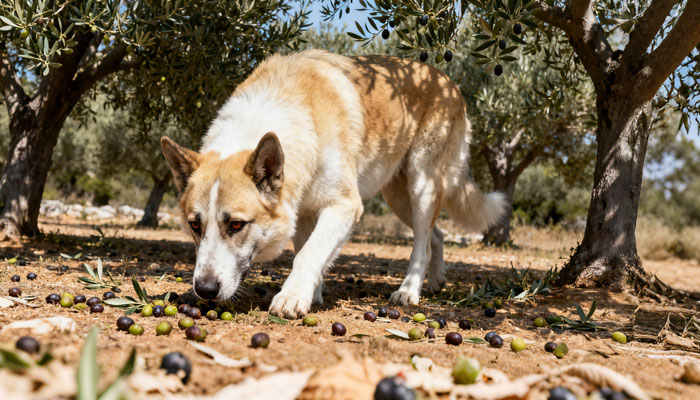Breed traits of the Anatolian Shepherd
I. Physical Features of the Anatolian Shepherd
The Anatolian Shepherd is a sturdy and strong dog. The height of a male is around 73.7 cm and the weight is about 49.9 to 68.04 kg. The height of a female is around 68.6 cm and the weight is about 36.29–54.43 kg. Being a quintessential large breed, the Anatolian Shepherd visually presents a balanced, rectangular-shaped body with muscles that are very well defined and no signs of fat, thus, meeting the functional requirements of a herding dog.
II. Head Features of the Anatolian Shepherd
The Anatolian Shepherd shows an intelligent expression that conforms to the breed’s reactive character. The eyes are medium-sized, almond-shaped, and their color ranges from dark brown to light amber. The eye rims can be black or brown. The look is concentrated and steady. The ears are V-shaped with rounded ends, around 10.2-15.2 cm long. The tips, which are the outermost parts of the ear, touching the outer corner of the eye, indicate the standard drop-ear conformation. The skull is big but harmonious with the body of the Anatolian Shepherd. The muzzle is dark, and the nose and lips are black or brown. It is recommended that a scissors bite be the proper occlusion.
III. Neck, Topline, and Body Features of the Anatolian Shepherd
The neck is a little curved on the upper side, strong, and well-muscled of medium length. A protective ruff around the neck is flaring almost like a collar, here the ruff is helpful, aesthetically and for defense. When a dog is in motion, the topline is a balance of level and back is strong, muscular, and straight, with the slight dip where the hips meet the back, creating an overall smooth line. With good expansion, the chest is deep providing plenty of space for the heart and lungs. A hock long, reaching to the tail, set high at the base is the tail. When the dog is on the alert, the tail is kept high and curled, acting as one the main indications of the Anatolian Shepherd’s emotional state.
IV. Anatolian Shepherd Leg Features
The forequarters look well-muscled with the long, broad and sloping shoulder blades. The elbows do not turn out nor in, thus, the forequarters can move in a coordinated way. Pasterns are straight, strong and well-boned, with compact, strong feet that can support the dog well. The hindquarters are as strong as the forequarters, the broad, muscular thighs being a source of powerful rear propulsion. The stifles are well-angled and hocks are proportionate to the hindquarters. From the back, the legs are parallel. The feet are oval-shaped. Overall, the limb structure is designed for running and guarding duties.
V. Coat and Color Features of the Anatolian Shepherd
The coat of an Anatolian Shepherd has two variations: one is short (about 2.5 cm) and coarse, the other one is loose and coarse (about 10.2 cm). The neck hair and mane are longer and thicker, and the dense undercoat that covers the whole body is there for protection against the elements. Feathering is seen on the edges of the ears, legs, hips, and tail, which makes the breed look even more attractive. As for the color, the Anatolian Shepherd may come in any color or pattern, which means a fairly wide range of color choices.
VI. Gait Features of the Anatolian Shepherd
When moving rapidly, the Anatolian Shepherd displays a powerful, strong and fluid gait that speaks of the large breed’s calm persona. The legs are vertical when viewed from the front or rear. With increasing speed, the feet move closer to the body’s centerline in order to minimize the air resistance. From the side, one can see that the forelegs are stretched out to the maximum in front of the withers and the topline which are almost at the same level. The hindquarters are not shy in giving the support needed as they drive us powerfully, the hocks at the same time are flexing freely. The overall gait is well- balanced, accustomed to long walking or running.
VII. Temperament Features of the Anatolian Shepherd
The Anatolian Shepherd is always on the lookout and is quite smart, he has a calm demeanour but is a bit cautious. Exceptional guarding instincts and innate protectiveness are what this guard dog shows, he responds to the threat bravely and adaptively. They are loyal to their owners to the point of being fanatical and have strong territorial instincts; as a result, they are good home guards. They keep a reserve towards strangers and usually don’t get overly excited. Such a temperament makes them not only good guard dogs but also great companions.
admin
-
Sale!

Washable Pet Cooling Pad for Cats and Dogs
$10.99Original price was: $10.99.$9.99Current price is: $9.99. This product has multiple variants. The options may be chosen on the product page -
Sale!

Washable Cat Window Hammock Cooling Bed
$23.99Original price was: $23.99.$22.99Current price is: $22.99. -
Sale!

Tropical Amphibian Rainforest Tank, Lizard Cage
$38.99Original price was: $38.99.$36.99Current price is: $36.99. -
Sale!

Silent 4-in-1 Waterproof Charging Dog Hair Trimmer
$49.88Original price was: $49.88.$47.99Current price is: $47.99.
